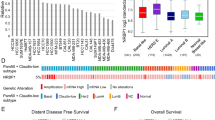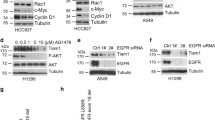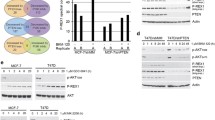Abstract
A yeast two-hybrid system was utilized to identify novel PI3K p110α-interacting proteins, of which receptor of activated protein kinase C1 (RACK1) was chosen for successive detailed analyses. Our aim was to investigate the function(s) of RACK1 and its involvement in mechanisms of breast carcinoma proliferation and invasion/metastasis. Experiments in breast carcinoma cell lines stably transfected with RACK1, as well as nude mouse models, showed that RACK1 promotes breast carcinoma proliferation and invasion/metastasis in vitro and in vivo. Conversely, knockdown of RACK1 by siRNA in vitro inhibited proliferation, migration, and invasion. In cell lines stably transfected with RACK1, p-AKT, cyclin D1, cyclin D3, and CD147 expression, as well as MMP2 activity, were elevated. RACK1-induced migration could be inhibited by the addition of Rho-kinase inhibitor. In 160 breast carcinoma cases, survival analyses established that RACK1 is an independent prognostic factor for poor outcome (P < 0.001). In conclusion, RACK1 is an independent prognosis-related factor and promotes breast carcinoma proliferation and invasion/metastasis in vitro and in vivo.






Similar content being viewed by others
References
McPherson K, Steel CM, Dixon JM (1994) ABC of breast diseases. Breast cancer epidemiology, risk factors and genetics. BMJ 309:1003–1006
Harbeck N, Dettmar P, Thomssen C, Berger U, Ulm K, Kates R, Höfler H, Jänicke F, Graeff H, Schmitt M (1999) Risk-group discrimination in node-negative breast cancer using invasion and proliferation markers: 6-year median follow-up. Br J Cancer 80:419–426. doi:10.1038/sj.bjc.6690373
Leevers SJ, Vanhaesebroeck B, Waterfield MD (1999) Signalling through phosphoinositide 3-kinases: the lipids take centre stage. Curr Opin Cell Biol 11:219–225. doi:10.1016/S0955-0674(99)80029-5
Vivanco I, Sawyers CL (2002) The phosphatidylinositol 3-kinase AKT pathway in human cancer. Nat Rev Cancer 2:489–501. doi:10.1038/nrc839
Samuels Y, Wang Z, Bardelli A, Silliman N, Ptak J, Szabo S, Yan H, Gazdar A, Powell SM, Riggins GJ, Willson JK, Markowitz S, Kinzler KW, Vogelstein B, Velculescu VE (2004) High frequency of mutations of the PIK3CA gene in human cancers. Science 304:554
Bachman KE, Argani P, Samuels Y, Silliman N, Ptak J, Szabo S, Konishi H, Karakas B, Blair BG, Lin C, Peters BA, Velculescu VE, Park BH (2004) The PIK3CA gene is mutated with high frequency in human breast cancers. Cancer Biol Ther 3:772–775
Broderick DK, Di C, Parrett TJ, Samuels YR, Cummins JM, McLendon RE, Fults DW, Velculescu VE, Bigner DD, Yan H (2004) Mutations of PIK3CA in anaplastic oligodendrogliomas, high-grade astrocytomas, and medulloblastomas. Cancer Res 64:5048–5050
Campbell IG, Russell SE, Choong DY, Montgomery KG, Ciavarella ML, Hooi CS, Cristiano BE, Pearson RB, Phillips WA (2004) Mutation of the PIK3CA gene in ovarian and breast cancer. Cancer Res 64:7678–7681
Zhao JJ, Gjoerup OV, Subramanian RR, Cheng Y, Chen W, Roberts TM, Hahn WC (2003) Human mammary epithelial cell transformation through the activation of phosphatidylinositol 3-kinase. Cancer Cell 3:483–495
Mao X, Kikani CK, Riojas RA, Langlais P, Wang L, Ramos FJ, Fang Q, Christ-Roberts CY, Hong JY, Kim RY, Liu F, Dong LQ (2006) APPL1 binds to adiponectin receptors and mediates adiponectin signalling and function. Nat Cell Biol 8:516–523. doi:10.1038/ncb1404
Ron D, Chen CH, Caldwell J, Jamieson L, Orr E, Mochly-Rosen D (1994) Cloning of an intracellular receptor for protein kinase C: a homolog of the beta subunit of G proteins. Proc Natl Acad Sci USA 91:839–843
Berns H, Humar R, Hengerer B, Kiefer FN, Battegay EJ (2000) RACK1 is up-regulated in angiogenesis and human carcinomas. FASEB J 14:2549–2558
Hunakova L, Sedlakova O, Cholujova D, Gronesova P, Duraj J, Sedlak J (2009) Modulation of markers associated with aggressive phenotype in MDA-MB-231 breast carcinoma cells by sulforaphane. Neoplasma 56:548–556. doi:10.4149/neo_2009_06_548
Bartusik D, Tomanek B, Lattová E, Perreault H, Fallone G (2010) Combined treatment of human MCF-7 breast carcinoma with antibody, cationic lipid and hyaluronic acid using ex vivo assays. J Pharm Biomed Anal 51:192–201. doi:10.1016/j.jpba.2009.07.032
Han HJ, Russo J, Kohwi Y, Kohwi-Shigematsu T (2008) SATB1 reprogrammes gene expression to promote breast tumor growth and metastasis. Nature 452:187–193. doi:10.1038/nature06781
Martin MD, Matrisian LM (2007) The other side of MMPs: protective roles in tumor progression. Cancer Metastasis Rev 26:717–724. doi:10.1007/s10555-007-9089-4
Okano K, Schnaper HW, Bomsztyk K, Hayashida T (2006) RACK1 binds to Smad3 to modulate transforming growth actor-beta1-stimulated alpha2(I) collagen transcription in renal tubular epithelial cells. J Biol Chem 281:26196–26204. doi:10.1074/jbc.M606710200
Hu L, Lu F, Wang Y, Liu Y, Liu D, Jiang Z, Wan C, Zhu B, Gan L, Wang Y, Wang Z (2006) RACK1, a novel hPER1-interacting protein. J Mol Neurosci 1:55–63
Besson A, Wilson TL, Yong VW (2002) The anchoring protein RACK1 links protein kinase Cεto integrin β chains: requirements for adhesion and motility. J Biol Chem 277:22073–22084. doi:10.1074/jbc.M111644200
Steele MR, McCahill A, Thompson DS, MacKenzie C, Isaacs NW, Houslay MD, Bolger GB (2001) Identification of a surface on the β-propeller protein RACK1 that interacts with the cAMP-specific phosphodiesterase PDE4D5. Cell Signal 13:507–513. doi:10.1016/S0898-6568(01)00167-X
Chang BY, Chiang M, Cartwright CA (2001) The interaction of Src and RACK1 is enhanced by activation of protein kinase C and tyrosine phosphorylation of RACK1. J Biol Chem 276:20346–20356. doi:10.1074/jbc.M101375200
Baumann M, Gires O, Kolch W, Mischak H, Zeidler R, Pich D, Hammerschmidt W (2000) The PKC targeting protein RACK1 interacts with the Epstein-Barr virus activator protein BZLF1. Eur J Biochem 267:3891–3901. doi:10.1046/j.1432-1327.2000.01430.x
Gallina A, Rossi F, Milanesi G (2001) Rack1 binds HIV-1 Nef and can act as a Nef-protein kinase C adaptor. Virology 283:7–18. doi:10.1006/viro.2001.0855
Hermanto U, Zong CS, Li W, Wang LH (2002) RACK1, an insulin-like growth factor I (IGF-I) receptor-interacting protein, modulates IGF-I-dependent integrin signaling and promotes cell spreading and contact with extracellular matrix. Mol Cell Biol 22:2345–2365. doi:10.1128/MCB.22.7.2345-2365.2002
Niculescu AB III, Chen X, Smeets M, Hengst L, Prives C, Reed SI (1998) Effects of p21(Cip1/Waf1) at both the G1/S and the G2/M cell cycle transitions: pRb is a critical determinant in blocking DNA replication and in preventing endoreduplication. Mol Cell Biol 18:629–643
Gu Y, Turck CW, Morgan DO (1993) Inhibition of CDK2 activity in vivo by an associated 20K regulatory subunit. Nature 366:707–710. doi:10.1038/366707a0
Harper JW, Adami GR, Wei N, Keyomarsi K, Elledge SJ (1993) The p21 Cdk-interacting protein Cip1 is a potent inhibitor of G1 cyclin-dependent kinases. Cell 75:805–816. doi:10.1016/0092-8674(93)90499-G
Cai K, Dynlacht BD (1998) Activity and nature of p21 (WAF1) complexes during the cell cycle. Proc Natl Acad Sci USA 95:12254–12259
Ogryzko VV, Wong P, Howard BH (1997) WAF1 retards S-phase progression primarily by inhibition of cyclin-dependent kinases. Mol Cell Biol 17:4877–4882
Egilmez R, Elagoz S, Kanik EA (2001) Cdk1/P34Cdc2 and P21waf expression in colorectal adenomas and carcinomas. J Exp Clin Cancer Res 20:549–552
Stein JP, Ginsberg DA, Grossfeld GD, Chatterjee SJ, Esrig D, Dickinson MG, Groshen S, Taylor CR, Jones PA, Skinner DG, Cote RJ (1998) Effect of p21WAF1/CIP1 expression on tumor progression in bladder cancer. J Natl Cancer Inst 90:1072–1079
Westfall MD, Mays DJ, Sniezek JC, Pietenpol JA (2003) The Delta Np63 alpha phosphoprotein binds the p21 and 14-3-3 sigma promoters in vivo and has transcriptional repressor activity that is reduced by Hay-Wells syndrome-derived mutations. Mol Cell Biol 23:2264–2276. doi:10.1128/MCB.23.7.2264-2276.2003
Vadlamudi RK, Kumar R (2003) P21-activated kinases in human cancer. Cancer Metastasis Rev 22:385–393. doi:10.1023/A:1023729130497
Kumar R, Gururaj AE, Barnes CJ (2006) p21-activated kinases in cancer. Nat Rev Cancer 6:459–471
Zigmond SH (1996) Signal transduction and actin filament organization. Curr Opin Cell Biol 8:66–73. doi:10.1016/S0955-0674(96)80050-0
Tapon N, Hall A (1997) Rho, Rac and Cdc42 GTPases regulate the organization of the actin cytoskeleton. Curr Opin Cell Biol 9:86–92. doi:10.1016/S0955-0674(97)80156-1
Kroll J, Epting D, Kern K, Dietz CT, Feng Y, Hammes HP, Wieland T, Augustin HG (2009) Inhibition of Rho-dependent kinases ROCK I/II activates VEGF-driven retinal neovascularization and sprouting angiogenesis. Am J Physiol Heart Circ Physiol 296:H893–H899
Yan L, Zucker S, Toole BP (2005) Roles of the multifunctional glycoprotein, emmprin (basigin; CD147), in tumour progression. Thromb Haemost 93:199–204. doi:10.1160/TH04-08-0536
Kanekura T, Chen X, Kanzaki T (2002) Basigin (CD147) is system with an improved hairpin and its significant expressed on melanoma cells and induces tumor cell invasion by stimulating production of matrix metalloproteinases by fibroblasts. Int J Cancer 99:520–528. doi:10.1002/ijc.10390
Friedl P, Wolf K (2008) Tube travel: the role of proteases in individual and collective cancer cell invasion. Cancer Res 68:7247–7249
Wang Z, Jiang L, Huang C, Li Z, Chen L, Gou L, Chen P, Tong A, Tang M, Gao F, Shen J, Zhang Y, Bai J, Zhou M, Miao D, Chen Q (2008) Comparative proteomics approach to screening of potential diagnostic and therapeutic targets for oral squamous cell carcinoma. Mol Cell Proteomics 7:1639–1650
Acknowledgment
This study was supported by National Nature Science Foundation of China (Nos. 30870972 and 30872971).
Author information
Authors and Affiliations
Corresponding author
Electronic supplementary material
Below is the link to the electronic supplementary material.
Rights and permissions
About this article
Cite this article
Cao, XX., Xu, JD., Xu, JW. et al. RACK1 promotes breast carcinoma proliferation and invasion/metastasis in vitro and in vivo. Breast Cancer Res Treat 123, 375–386 (2010). https://doi.org/10.1007/s10549-009-0657-x
Received:
Accepted:
Published:
Issue Date:
DOI: https://doi.org/10.1007/s10549-009-0657-x




